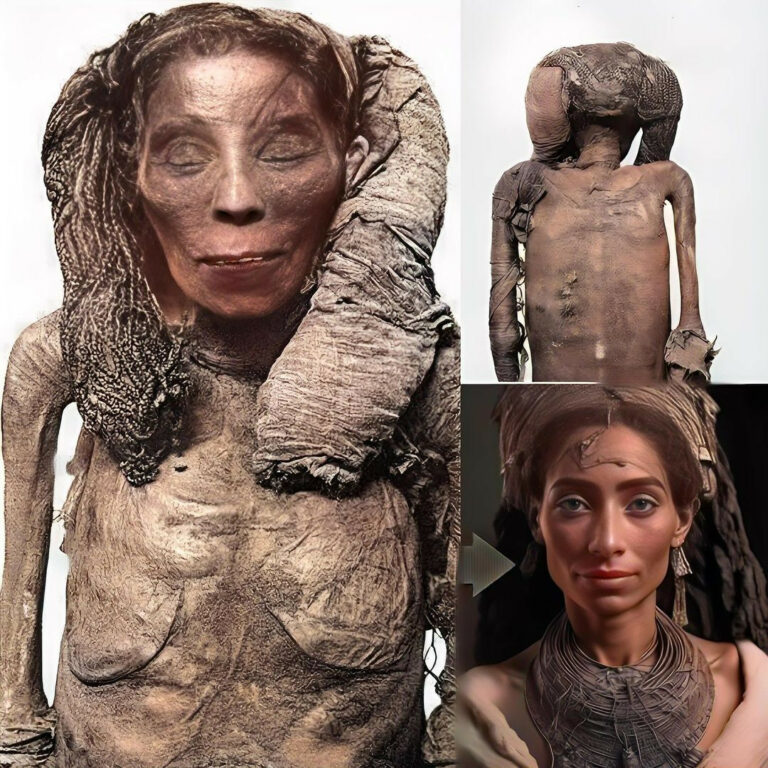In the sun-scorched deserts of ancient Egypt, a hidden story lay buried beneath the sands for millennia, waiting to be unearthed and shared. This tale begins during the early 18th Dynasty, around 1530 BC, and has transcended time to captivate and intrigue us even today.
In 1881, a monumental discovery changed the course of Egyptology forever. While archaeologists meticulously excavated the sands at Deir el-Bahari near Luxor, they stumbled upon a find that would rewrite history books. Among their remarkable discoveries was the mummy of a petite woman, standing only 4 feet 11 inches tall. Despite her small stature, her legacy loomed large, as this was Lady Rai, a royal nursemaid entrusted with caring for Queen Ahmose-Nefertari. Her discovery sparked an interest that continues to resonate in the world of archaeology and ancient history.

Lady Rai’s mummy was not just another relic of the past; it represented a stunning miracle of preservation. For over 3,500 years, her remains had defied the inevitable decay of time, thanks to the ancient Egyptians’ meticulous and sophisticated mummification processes. Unlike many other mummies that were ravaged by the elements or grave robbers, Lady Rai’s body had remained extraordinarily intact, offering modern researchers a window into a world long gone. This exceptional state of preservation became an unparalleled resource for understanding the lives, health, and rituals of ancient Egyptians.
The journey to uncover Lady Rai’s secrets didn’t end with her initial discovery. Fast forward to 2009, when modern technology intersected with ancient history. A computed tomography (CAT) scan of Lady Rai’s mummy revealed an astonishing medical revelation. Hidden within her ancient body was evidence of atherosclerosis in her aortic arch. This discovery made her the oldest known case of this condition, challenging contemporary assumptions about the prevalence of heart disease. It also painted a vivid picture of the health and lifestyle factors that influenced even the elites of ancient Egypt. Through Lady Rai, we gain insight into how diet, genetics, and daily living might have contributed to such ailments thousands of years ago.
Lady Rai’s tomb was a veritable treasure trove, filled with items that reflected her high status in Egyptian society. The artifacts discovered alongside her—jewelry, pottery, and cosmetics—weren’t merely decorative. These items were believed to be essential for the afterlife, ensuring that the deceased would be well-equipped for their eternal journey. This deep-seated belief in the afterlife was central to Egyptian culture, and Lady Rai’s burial goods serve as a testament to the spiritual and material priorities of her time. Each item tells a story of craftsmanship, societal values, and the unwavering belief in life beyond death.
The study of Lady Rai’s mummy has also provided an extraordinary understanding of ancient mummification techniques. Her body, intricately wrapped in linen bandages that bore her name, stands as a testament to the skill and care of Egyptian embalmers. Her tightly plaited braids, astonishingly preserved, offer a glimpse into the grooming habits and aesthetic practices of ancient Egyptian women. These details reveal a civilization deeply invested in both practical preservation and artistic expression, ensuring that individuals like Lady Rai would remain dignified in death as they were in life.
Today, Lady Rai’s remains rest in the Egyptian Museum in Cairo, where she continues to inspire awe and fascination among scholars and visitors from around the globe. Her extraordinarily well-preserved body serves as a tangible link to an era that shaped human history. Through her, we can reach back across millennia, bridging the gap between the ancient world and our modern one. The curiosity and reverence she inspires remind us that history is not merely a collection of dates and facts but a living, breathing connection to our collective past.
The story of Lady Rai is more than just a historical narrative; it is a profound reminder that the secrets of the past are never truly lost. Buried under the sands of time, they wait for the right moment to be rediscovered, enriching our understanding of human history and the enduring legacy of ancient civilizations. Lady Rai’s life, death, and remarkable preservation illustrate the universal human desire to connect with those who came before us. Her story, brought to light after thousands of years, continues to illuminate the ingenuity, spirituality, and resilience of a culture that laid the foundations for so much of what we know today.
Through the lens of Lady Rai’s extraordinary tale, we are reminded that history is not static; it is a vibrant, evolving story with lessons that remain relevant to this day. From her role as a caretaker of royalty to her preserved remains that offer unprecedented medical and cultural insights, Lady Rai bridges the ancient and modern worlds. Her legacy underscores the timeless nature of human curiosity and our collective quest to understand the civilizations that shaped us. Lady Rai, though diminutive in stature, stands as a towering figure in the annals of history, offering us a remarkable glimpse into the brilliance and complexity of ancient Egypt.





